#St Euphrosine
Explore tagged Tumblr posts
Note
Tysm for the reply, and such a detailed one with the links at that!!! It was fascinating to read!
I also have some thoughts:
Jesus combining Mary and thus becoming a hermaphrodite makes me think about Adam. The word for a male man ("ish") isn't used in the Bible until the creation of Eve, before that Adam is called just Adam - a human. This leads many to believe that he was created as intersex, either containing both sexes at once or none. And since the Church gives the title of The New Adam to Jesus and The New Eve to Mary, and since Jesus is to reverse Adam's sin and bring humanity back to its natural state from the original paradise, this image makes sense. If Adam was "split into" himself and Eve (he wasn't exactly and also it was God's idea not a result of sin but let's go with that for now) and lost the paradise afterwards, Jesus was "combined with" Mary, became the original perfect human, and regained the paradise.
The claim that 'wherever there's Jesus there's also Mary and vice versa' also seems in tune with the mariology of St Louis de Montfort (see: "True Devotion to Mary"), which is widely accepted by the Catholic Church even today - although to claim He's intersex because of that would be too far-fetched.
I have a whole argument and a half about how the crucifixion bears a lot of resemblance to the childbirth (like eg. the birth canal thing, frequently appearing phrase "of His wound the Church was born", John's Gospel using the Greek word kolpos when refering to both Jesus and His Father that could be translated either as a heart/breast or as a womb/female reproductive organs, Jesus kinda breastfeeding His children but with blood instead of milk, and because of it being very often likened to a pelican mother who medieval scholars believed to do the same, and so on).
A couple of images of female pelican being a symbol of Christ for anyone interested (fun fact! our parish priest has one garment adorned with the same image and it's my favorite piece of priestly clothing ever, I'm hyped whenever he wears it) :
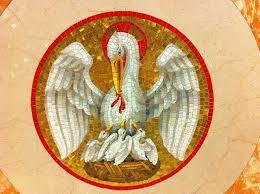
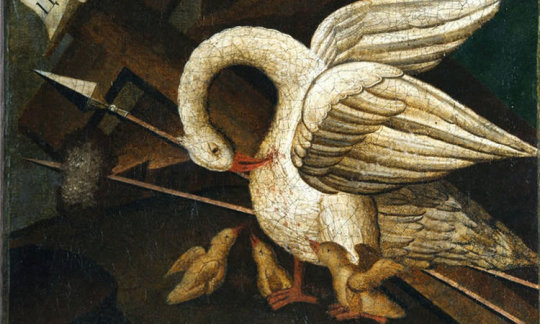
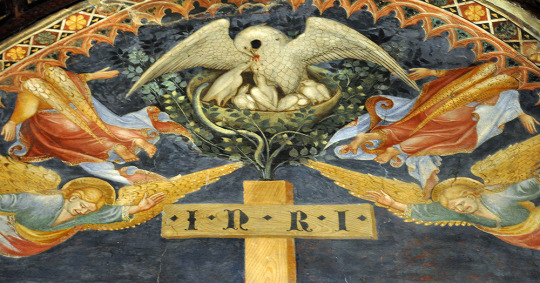
Yay, St Wilgefortis mentioned! I love her and her legend, sometimes you ask Jesus for a way out and He gives you a beard. Although I only encountered versions of the story where she was female with a beard and some male features, not intersex, and her shoe falling off during the crucifixion, not some weird joke (also what's the joke cause I don't get it and you got me curious?).
As a side note, there are many other saints who defy our modern understanding of gender, the medieval times were very cool for that. Just to name my favorite few there are e.g. St Euphrosyne/Smaragd (a girl who wanted to stay virgin for Christ so she ran away from marriage to a male monastery where she did a Mulan on everyone for practically her whole life and the best things is, they found out eventually and they didn't kick her out cause "hey, you'll always be brother Smaragd for us, you're cool") and St Francis (yes that St Francis of Assisi, who when asking for a blessing to establish an order was said to tell the pope: "I am the Bride of Christ and this is the way He wants me to bear His children").
Those two below are both Euphrosyne!
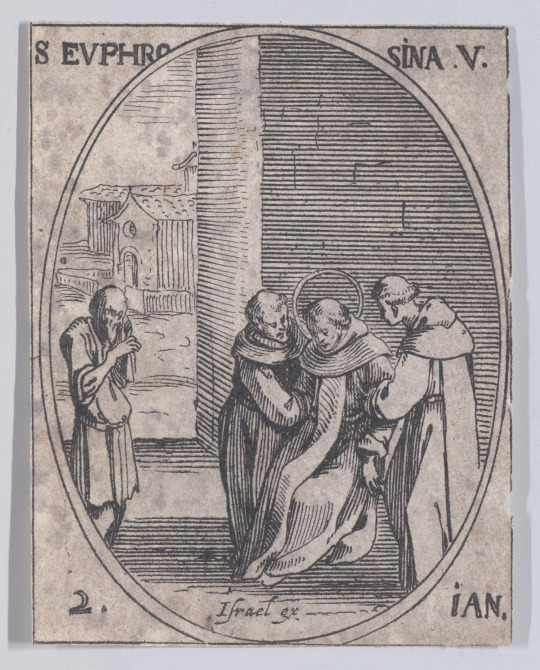
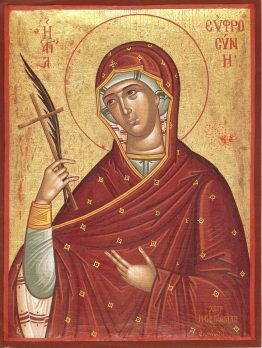
And though it's interesting to see it done to His human form, depicting the Son as a woman isn't actually that recent. It dates back to the Old Testament and Lady Wisdom, a personification of God's wisdom from the Book of Proverbs, whom at least Catholic doctrine believes to be Word/the Son/Jesus, giving Jesus the title of Wisdom Incarnate. She was consistently depicted as a young, very beautiful woman.
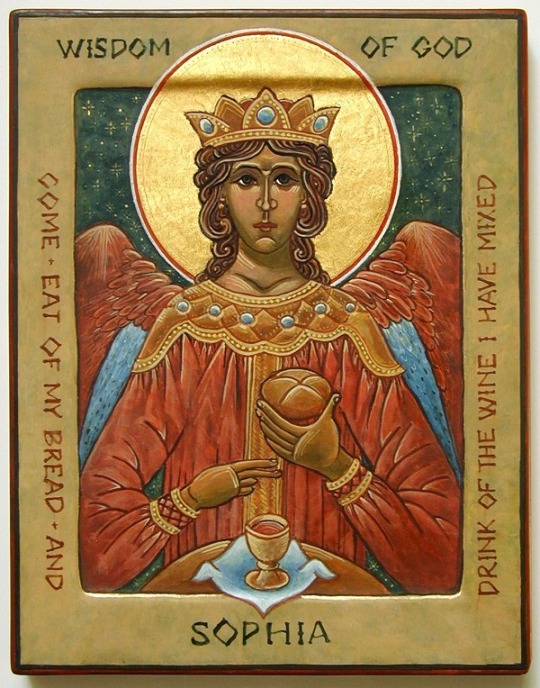
While the understanding of concepts of sexual orientation and gender back then were very different to what we believe today so people most likely didn't identify as gay or trans, it's true that the Church was the most welcoming place (and still is apart from its highly conservative members, fight me) for everyone who was different, weird, or socially unacceptable. Yes you have to follow the morality and commandments of course, but the weirdness is never the issue. Heck, the Hebrew word for "saint" (kadosh) literally means "different/weird"! It seems they may have understood the assignment far better back then than we do today.
Hi! I saw a post where you mentioned intersex Jesus being a part of medieval European alchemy and I'd love to learn more about that. Could you elaborate or maybe provide links to some articles? I know some saint mystics talked about Jesus being our Mother, and the holy wound in His side was often likened to a birth canal, especially in medieval times. Is it connected to that in any way?
I'd love to elaborate! (This is going to be a long post so buckle up lol)
I will be using the word "hermaphrodite" instead of "intersex" because that is the word that primary sources from medieval Europe and contemporary medieval scholars use when talking about this subject
The best scholarly article I've found is "The Jesus Hermaphrodite: Science and Sex Difference in Premodern Europe" by Leah DeVun. It talks about how the image of the hermaphrodite was used in a metaphorical way by alchemists to show the combining/transforming of two different metals. They believed that certain metals/elements were gendered, so combining male and female "traits" would make something of a completely new sex; similar to the way they perceived hermaphrodites as both but also neither sex.
The article then goes on to talk about two medieval texts: Aurora consurgens and the Book of the Holy Trinity. Aurora consurgens is an alchemic text and has the image below in it. The hermaphrodite is holding a rabbit and bat, both of which were thought to be hermaphroditic species where both males and females gave birth, to emphasize their dual sexuality as well as the conflicting male and female attributes of alchemy.

The Book of the Holy Trinity transitioned from the traditional alchemic hermaphrodite, like seen above, into the religious sphere by arguing that Jesus and Mary were two sides of the same coin. The author of the text says, "one can never see the mother of God without also seeing that God eternally hides and intermingles [his mother] within him. God was and is eternally his own mother and his own father, human and divine, his divinity and his humanity intermingled within. And he depends on that which he wishes to be hidden most of all within himself, the divine and the human, the feminine and the masculine." This makes Jesus/Mary a hermaphrodite.
As a bit of a fun side note to your ask, the author of the Book of the Holy Trinity gives a few more supporting points to his argument and then turns to say that as Christ contains Mary, He also contains the Antichrist which the Book illustrates like this:

The idea of the hermaphrodite Christ really took off after that and boosted the cult of Saint Wilgefortis, saint of monsters. Images of the hermaphrodite Wilgefortis were often indistinguishable from images of Christ because they were both depicted on a cross but where they both have beards, Wilgefortis only has one shoe on: a playful medieval illusion to female sex organs. Images of Saint Wilgefortis below (some images from the 1800s, some from the 1400s). You can read more about Wilegfortis in Bearded Woman, Female Christ: Gendered Transformations in the Legends and Cult of Saint Wilgefortis by Lewis Wallace.




About a hundred years later, “The Lamentation around the remains of Christ,” below, was made depicting Jesus with breasts and feminine curves. Not much is known about it and Christ's hermaphroditic traits weren't even discovered until it was restored in the 21st century. Because of how recent this discovery is, not much scholarly work has been published on it, but I did find this: "The androgyny of Christ" by H. Valdes‑Socin. It is now at the Museum of Notre-Dame à la Rose Hospital in Lessines, Belgium.

And you're absolutely right about Christ's stab wound being like a birth canal! I think the article Mysticism and queer readings of Christ’s Side Wound in the Prayer Book of Bonne of Luxembourg by Dr. Maeve K. Doyle does a good job of explaining it. Dr. Doyle says, "The image of the side wound, ... grants feminine bodily attributes to Christ, destabilizing assumptions about his gender. In mystical images and texts, Christ’s capacity to transcend the gender binary, like his capacity to transcend the binary of life and death, underscores his divinity." Dr. Doyle then goes on to talk about how images of the stab wound looking like a birth canal would also be comforting to medieval women, trans people, and homosexuals on both sides. Now I'm not Christian but I think it's really amazing that such a simple image can elicited so much comfort and joy in so many groups of people who were not able to fully be themselves in the era they lived in. It was a reminder that even Christ was like them, their feelings were valid (to an extent), and that Jesus loved them anyway. Medieval Jesus stab wounds below for people interested.



----
Just for fun here are some more cool things!

A medieval wooden architectural relief with a person with a beard, phallus, and breasts

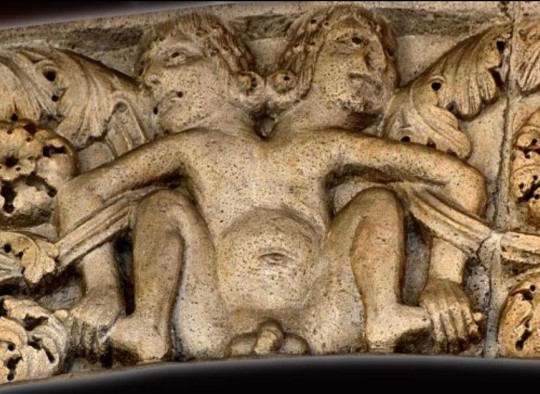
Potta di Modena Metope/The Hermaphrodite (left) and detail from the Southern Archivolt (right) of the Modena Cathedral Modena, Italy, c. 1099-1319, Marble reliefs
The Potta di Modena Metope (left) is damaged because people in the 1500s thought it was too sexual/offensive so they vandalized it
More journal articles:
Bearded Women in Early Modern England by Mark Albert Johnston
The Third Sex: The Idea of the Hermaphrodite in Twelfth-Century Europe by Cary J. Nederman
Transvestites in the Middle Ages by Vern L. Bullough
#long post I know but I'm passionate about the subject and wanted to do it justice#Jesus as a hermaphrodite#although I don't believe it in the literal sense the symbolism and understanding of it is great#and let's just say for all the gender non conforming behavior Jesus presents throughout the Bible I'm not even that suprised#He wanted all people to be loved and cared for so He didn't care about societal norms that forbade it#not that gender non conforming behavior tells you anything about one's gender! it doesn't!#remember kids God doesn't have a gender or sex (or rather has all of them) only Jesus as a human does#christianity#jesus#my beloved#medieval stuff#St Wilgefortis#St Euphrosine#god#brother Smaragd#St Francis#St Louis-Marie Grignion do Montfort#St Mary#cw childbirth
35 notes
·
View notes
Text
Yeah i get where you're coming from but asexuality is not flowers and unicorns, sadly 😅 For every 'being saved from sin by grace' area there are always other 'having tendencies to sin' areas. And the more blessed by God a person is, the harder the devil will work to tempt them. Not to say asexuals are especially blessed by God, not more than other people, it's just an orientation (or a lack of one depending on how you view it), it's got its advantages and disadvantages. Also there are many types of asexuality and some of them do nothing to keep you from sinning heh. So although it does help in some cases, i don't think it's anything to especially glorify, really
Now excuse me while i get back to training my push-ups, high kicks, and karate chops for the day they invent a time machine-
There were probably some medieval asexuals that were absolutely insufferable on their moral high horse about it. Like "this modesty shit easy - I haven't lusted over any man ever in my life and only fuck my husband out of duty from God and only so that we have children. I am so much better than any of you hoes."
And some other local goodwife would get sick of this and go "well obviously you don't have time for cock, Maergaret, since you're always too fucking busy choking on your own vanity and pride!" and have a smackfight that progresses into a full-on two-woman brawl in the town square. People gather around to watch this until a clergyman shows up to remind everyone that not only is this kind of brawl between good christians definitely a sin, it's also a sin for everyone who's watching to place bets on who's going to win.
#medevial!kaleb would not be that dissimilar from modern!kaleb#basically#lots of shame and self hatred (and meditating on the jesus prayer)#would join a monastery for sure and devour myself to religious service and poetry#and bridal theology#I would write the weirdest poetry about jesus#<-#nooo don't hate yourself if you can help it you're so wonderful and loved *hugs you very tight*#and same bro same everything you said#i would well i would just pull a St Euphrosine really that's just how my life would look#unless my family would not force me to marry some guy then i would probably end up in a nunnery a female one#i wonder which orders (male or female) were more fun#probably the differences in gender expression were way different back then compared to today#the society was very different in general#although i'd risk arguing any religious orders are gnc by definition so#YOOOOOO i just thought we could be like Francis and Clare!!!! :D#christianity#medieval stuff#asexual
28K notes
·
View notes
Text
I-I'm an Honorary Brother? 🥹🥹🥹
The Lord had said to Abram, “Go from your country, your people and your father’s household to the land I will show you."
Genesis 12
Listen, daughter, and pay careful attention: Forget your people and your father’s house. Let the king be enthralled by your beauty; honor him, for he is your lord.
Psalm 45
I will make you into a great nation, and I will bless you; I will make your name great, and you will be a blessing. I will bless those who bless you, and whoever curses you I will curse; and all peoples on earth will be blessed through you."
Genesis 12
Your sons will take the place of your fathers; you will make them princes throughout the land. I will perpetuate your memory through all generations; therefore the nations will praise you for ever and ever.
Psalm 45
...I think i am onto something
#yay!!!#very St Euphrosine coded#which makes me so happy because honestly i kin my girl so much haha#i've found my niche#i love it here#and you are so right nobody is safe mwahahaha!#christianity#bridal theology#genesis#psalms#abraham#also replying to prev ->#bestie#im sold#avraham is yahweh’s wife#tracks to me#<- good good very good. all according to plan#and what the plan is? haha well. let's justr say. God only knows (cause i don't)
16 notes
·
View notes